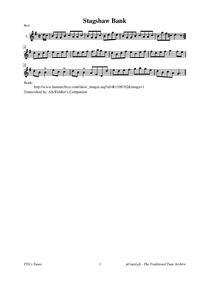Template:Pagina principale/Vetrina Alternativa: Difference between revisions
No edit summary |
No edit summary |
||
| Line 1: | Line 1: | ||
{{SheetMusic | {{SheetMusic | ||
|f_track= | |f_track=Stagshaw Bank Fair.mp3 | ||
|f_pdf= | |f_pdf=Stagshaw Bank Fair.pdf | ||
|f_artwork= | |f_artwork=Stagshaw2.jpg | ||
|f_tune_name= | |f_tune_name=Stagshaw Bank Fair | ||
|f_track_title= | |f_track_title=Stagshaw_Bank_Fair | ||
|f_section=abc | |f_section=abc | ||
|f_played_by=[https://soundcloud.com/ | |f_played_by=[https://soundcloud.com/edric-ellis Edric Ellis] | ||
|f_notes= | |f_notes= Proclaiming Stagshaw Fair at Corbridge, Northumberland." Ralph Hedley, 1882 | ||
|f_caption= | |f_caption=This fair, which was one of business as well as pleasure, was the largest held in England for one day and for business people came to it from all parts of the United Kingdom. | ||
|f_source=[https://soundcloud.com/ | |f_source=[https://soundcloud.com/edric-ellis/stagshaw-bank-fair-herd-on-the Soundcloud] | ||
|f_pix=420 | |f_pix=420 | ||
|f_picpix=200 | |f_picpix=200 | ||
|f_article=[[ | |f_article=[[Stagshaw_Bank_Fair | '''Stagshaw Bank Fair''']] | ||
The | The tune, as "Stagshaw Bank", also was entered into a c. 1887 manuscript compiled by the Society of Antiquities, entitled "Airs and dance tunes collected and constructed by the Melodies Committee of the Newcastle Antiquarian Society, 1857-1887," a compendium of their collecting work of local Northumbrian tunes over several decades. | ||
Their work formed the basis from which much of the contents of Bruce & Stokoe's Northumbrian Minstrelsy is drawn, and continued for several years after the publication of that volume. | |||
The tune is thought to be the work of Robert Bewick. | |||
Stagshaw Bank Common is located just south of the Roman Wall in Northumberland. | |||
For centuries it was the scene of two great annual fairs held on the day before Whit Sunday and on July 4th. From 1820 a third annual fair was held on November 24th. | |||
The fairs gradually died out during the last half of the 19th century. | |||
}} | }} | ||
Revision as of 07:26, 30 December 2023

Played by: Edric Ellis
Source: Soundcloud
Image: Proclaiming Stagshaw Fair at Corbridge, Northumberland." Ralph Hedley, 1882

The tune, as "Stagshaw Bank", also was entered into a c. 1887 manuscript compiled by the Society of Antiquities, entitled "Airs and dance tunes collected and constructed by the Melodies Committee of the Newcastle Antiquarian Society, 1857-1887," a compendium of their collecting work of local Northumbrian tunes over several decades.
Their work formed the basis from which much of the contents of Bruce & Stokoe's Northumbrian Minstrelsy is drawn, and continued for several years after the publication of that volume.
The tune is thought to be the work of Robert Bewick.
Stagshaw Bank Common is located just south of the Roman Wall in Northumberland.
For centuries it was the scene of two great annual fairs held on the day before Whit Sunday and on July 4th. From 1820 a third annual fair was held on November 24th.
The fairs gradually died out during the last half of the 19th century.
...more at: Stagshaw Bank Fair - full Score(s) and Annotations
X:1 T:Stagshaw Bank Fair M:C L:1/8 R:Reel S:Bruce & Stokoe – Northumbrian Minstrelsy Z:AK/Fiddler’s Companion K:G d/c/|BGGB cAAc|BGGc Gdbd|BGGB cAAc|Bge^c d3:| |:e|dBdg eceg|fdef gage|dBdg eceg|fdef g2 fe| dB B2 ec c2|dB B2 AFDd|edef gage|dBcA G3:|
